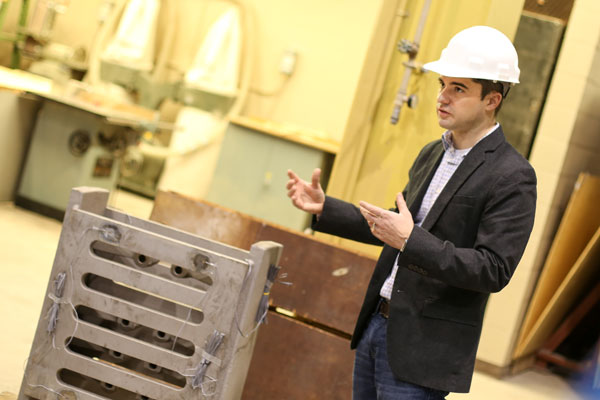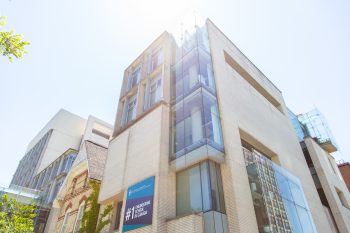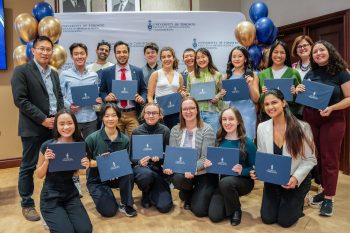U of T Engineering alumnus Michael Gray (CivE PhD 1T2) has a dream for the ideal city, and it’s built to the highest safety and aesthetic standards.
Now, he is setting those standards with Toronto-based startup Cast ConneX—a successful spin-off of graduate research performed under professors Jeffrey Packer and Constantin Christopoulos (both CivE)—co-founded with fellow alumnus Carlos de Oliveira (CivE MASc 0T6). Their company grew and benefited in part from support for de Oliveira’s research funded by the Heffernan Commercialization Fellowship, which is aimed at enabling graduate students to transfer their research into successful businesses. [Learn more about the Heffernan Commercialization Fellowships].
Cast ConneX designs steel castings that strengthen new and old buildings for earthquake resistance. In summer, 2013, the company began construction on two of its first major projects using the technology developed in Gray’s doctoral research: the Audain Art Museum in Whistler BC, and a retrofit for the St. Aubin High School in Baie-Saint-Paul, Quebec—the site of one of the worst recorded earthquakes in Canadian history.
They have also started several major projects in the United States, including the TransBay Center in San Francisco, CA and a new retractable roof for the Arthur Ashe Stadium in Flushing, New York.
Grounded in research, the dynamic startup constructs and retrofits for earthquake resistance, and their designs enable unique and novel structures. The company is setting its sights on new standards for design and safety.
Resisting seismic forces
“My PhD research at U of T was in developing a ‘Scorpion’, which is a high performance earthquake device that can also solve architectural problems,” said Gray.
Steel castings like the Scorpion are made by pouring liquid steel into molds, then letting it cool into a solid.
The most recent iteration of the Scorpion resembles a small ladder with fingers between the rungs [see cover image]. The connectors are installed at the end of a diagonal brace member that spans from one story to another. Those fingers transmit the brace load via bolts through their ends. If an earthquake strikes, the fingers are deformed in flexure, absorbing earthquake energy so that the building doesn’t have to.
[youtube https://www.youtube.com/watch?v=TAXpwimvbjA&w=560&h=315]
“What we do is unique because casting has been used for mechanical applications for a long time, but we’re among the first to use it in structural engineering. It’s attractive because of its potential for free form geometries, meaning you can construct non-traditional designs and unlikely angles,” said Gray.
Buildings are normally constructed using weld fabrication: support beams are cut from large, mass-produced steel plates and then welded together, which restricts the potential for interesting geometries and unique designs. This fabrication process creates challenges when designing for the devastating effects of earthquakes.
Weld fabrication can also be challenging in remote areas where tools and expertise are not readily available. In 2010, after a devastating earthquake struck Haiti and displaced approximately 1.5 million people, Cast ConneX donated their steel castings to enable the construction of an earthquake resistant school in Port-au-Prince, the country’s capital. The project was part of an industry-wide coalition to prepare the island nation for future natural disasters.
Architectural applications
In addition to earthquake resistance, Cast ConneX’s innovative steel castings enable unprecedented architectural designs. Structures like the Queen Richmond Centre (QRC) at Richmond and Peter Streets in Toronto, with its distinct Xs adding

architectural intrigue as well structural support.
“The architect came to us with designs, and we figured out how to make them work,” said Gray. “The connection joints that make the Xs at the QRC so distinctive also makes them virtually impossible under the restrictions of traditional construction techniques.”
In projects like the Queen Richmond Centre when custom castings are needed, Cast ConneX leverages their engineering expertise to help architects translate their designs to foundries—factories that produce metal castings. This casting technology opens the doors for shifts in the architecture of new buildings, creating opportunities for never before seen structures.
“Designers come to us with an idea, and we make it a reality,” said Gray.
Safety by design
In the future, Gray’s perfect city is built to the highest standards of safety and aesthetics.
“Safety is paramount,” said Gray. “In my ideal world, we’d have more motivation to push buildings to higher performance levels. Right now, all of our buildings are built to ‘code.’ We need to move beyond code minimum; we need to elevate our standards. And not just for safety, for design, too.”
Gray believes better management of our built environment is possible with intentional design and higher safety standards.
“Investing in our cities and structures is important, and it will pay off.”




